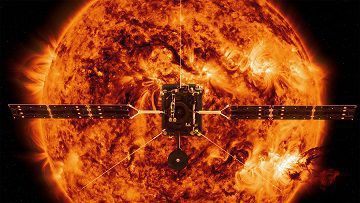Solar Maximum Surges: Scientists are surprised by the sun’s increased activity. As it nears the peak of its solar cycle, our star is becoming more active, according to CNN’s Ashley Strickland. Sunspots mark this 11-year cycle of low and high solar activity. The sun’s magnetic fields drive these dark regions, which may be larger than Earth.
Solar maximum is when the sun goes from calm to active. Sun’s magnetic poles flip during peak activity. Solar minimum follows maximum. Scientists predicted that Solar Cycle 25 would peak in July 2025. Recent findings suggest the peak may occur earlier, in mid- to late 2024.
Solar Cycle 25 exceeded expectations. The National Oceanic and Atmospheric Administration’s Space Weather Prediction Center in Colorado has seen more sunspots this cycle than during the previous peak. Like all solar cycles, this one is unique. It’s stormy like hurricane season. Solar maximum lasts years, unlike hurricane season, which lasts months.
Solar flares and CMEs are intensifying. Solar flares are powerful energy bursts, while CMEs are massive clouds of ionized gas and magnetic fields from the sun’s outer atmosphere. Solar storms can disrupt GPS, aviation, power grids, and low-Earth orbit satellites. They can cause radio blackouts and endanger human space missions.
NASA’s SDO captured an X1 solar flare on October 2, 2022. Solar flares affect radio, power, and navigation signals. However, solar flare radiation cannot penetrate Earth’s atmosphere and harm humans. However, studying these flares helps scientists understand them and prepare for disruptions.
In January 2022, solar coronal mass ejections heated and expanded Earth’s outer atmosphere. This expansion burned 38 of SpaceX’s 49 Starlink satellites. As we approach solar maximum, solar activity will increase as usual.
Dr. Alex Young, NASA’s Heliophysics Science Division’s associate director for science, says this is expected. Sunspot clumps will increase as solar maximum approaches, boosting activity. It’s nature’s cycle.
Predicting solar maximum is difficult, experts say. If the sun’s northern and southern hemispheres are out of sync, a solar cycle may have two peaks. Sunspots peak at different times in each hemisphere, resulting in an extended maximum.
Solar maximum lasts two years before activity decreases. Even after the peak, solar storms are likely. Solar activity is still high, but it’s decreasing.
Despite the potential disruptions, increased solar activity produces stunning auroras, also known as the northern and southern lights. Coronal mass ejection particles interact with Earth’s magnetic field to create colorful sky displays.
Solar storms have caused auroras to appear in unexpected places like the US and UK. Auroras can be stunning even when not directly overhead.


READ MORE: Inferno Unleashed: Brace for Unprecedented Heatwave
Alaska, Canada, Iceland, Norway, Scandinavia, and the upper peninsula of Michigan offer intense auroras. Auroras are breathtaking.
The Space Weather Prediction Center uses magnetic maps, ground and space-based observatories, and ultraviolet observations of the sun’s outer atmosphere to predict and track solar storms. This data lets them forecast, warn, and alert space weather victims. To prepare, the center sends notifications hours to weeks in advance.
Due to ionosphere disruptions, solar storms can immediately affect GPS and communications. Sun-emitted energetic particles can damage spacecraft electronics and endanger astronauts without protection. Coronal mass ejections take 3072 hours to reach Earth, causing geomagnetic storms that can disrupt satellites and create electrical currents in the upper atmosphere. These events affect power grids, flight patterns, and other critical systems.
NASA’s Parker Solar Probe and the European Space Agency’s Solar Orbiter aim to reveal the sun’s secrets, but predicting major solar storms is difficult. These missions help us understand and predict the sun’s internal processes. Scientists also eagerly await the total solar eclipse on April 8, 2024, to study the sun.
Humans have long admired the sun. It anchors our solar system and provides life-sustaining warmth and light. The sun’s interior and magnetic activity remain mysterious. As we study this amazing celestial body, we learn more about its profound impact on our lives and its role
Our Reader’s Queries
What year is the next solar maximum due?
Dr. Ryan French, a solar physicist at the National Solar Observatory (NSO) in Boulder, Colorado, revealed that the latest forecast anticipates a solar maximum from January to October 2024. Dr. French, author of The Sun: Beginner’s Guide To Our Local Star, shared this update via email.
Are we safe from solar maximum?
In powerful solar storms, Earth’s magnetic field gets disrupted, causing geomagnetic storms to break through the magnetosphere. This can result in widespread radio and power outages, putting astronauts and satellites at risk. Such events occur more frequently during solar maximum.
What is the solar maximum Carrington event?
The Carrington Event stands as the most powerful geomagnetic storm ever documented, reaching its peak during solar cycle 10 on September 1 to 2, 1859. Its impact was felt worldwide, producing vibrant auroras and sparking fires in numerous telegraph stations.
Is a solar storm coming 2024?
The likelihood of significant space weather events is greater than normal in 2024 and 2025, posing a larger threat than in 2023.

